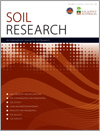SR18331Agriculture changes soil properties on the Galápagos Islands – two case studies
 , Armin Bajraktarevic, Katharina Keiblinger
, Armin Bajraktarevic, Katharina Keiblinger  , Axel Mentler, Maria Rechberger, Johannes Tintner, Karin Wriessnig, Michael Gartner, Xavier Salazar Valenzuela, Alexandra Troya, Paulina M. Couenberg, Heinke Jäger, Jorge E. Carrión and Franz Zehetner
, Axel Mentler, Maria Rechberger, Johannes Tintner, Karin Wriessnig, Michael Gartner, Xavier Salazar Valenzuela, Alexandra Troya, Paulina M. Couenberg, Heinke Jäger, Jorge E. Carrión and Franz Zehetner
This paper describes the impact of agricultural management on soil properties on the Galápagos archipelago by comparing arable soils on two islands with the adjacent soils in the national park on identical lava flows. Soil organic carbon stocks, nitrogen, mobile macro- and micronutrients, and microbial parameters changed considerably due to conversion to agriculture. Microbial parameters indicate changes in the nitrogen cycle and impact of fungicides and insecticides found in the arable plots.




